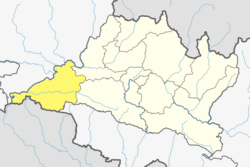Kalika municipality कालिका tempol [का.न.पा.] | |
|---|---|
| Coordinates: 27°41′35″N84°34′19″E / 27.693°N 84.572°E | |
| Country | |
| Province | Bagmati Province |
| District | Chitwan District |
| Government | |
| • Mayor | Mr.Binod Regmi (विनोद रेग्मी) (CPN-UML) |
| • Deputy Mayor | Mrs.Bimala Tamang (विमला तामाङ) (CPN-UML) |
| • Executive Officer | Mr. Chudamani Sharma Gautam |
| Population (1991) | |
• Total | 28,611 |
| Time zone | UTC+5:45 (NST) |
| Website | kalikamun.gov.np |
Kalika is a municipality in Chitwan District in the Narayani Zone of southern Nepal. This municipality was established in 2015 AD by merging the existing Jutpani, Padampur, Shaktikhor and Siddhi VDCs. [1] [2]


